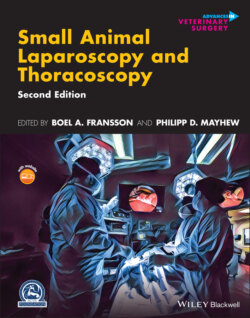Читать книгу Small Animal Laparoscopy and Thoracoscopy - Группа авторов - Страница 59
Knot Tying Using a Vertical Plane: The “Rosser Technique” (Figure 2.18, Video 2.3)
ОглавлениеWith this method, the right‐hand instrument (needle driver) is always creating the throws around the left‐hand instrument. When maximal driving along the arc of the needle has occurred, the right‐hand needle driver is used to grasp the tip of the needle to disengage it from the tissue. The same instrument can then hold the needle without repositioning throughout the tying.
This tying technique lends itself best if a short suture (15 cm or less) and is quick. Disadvantages include tightening of the second throw with crossed instruments. Holding on to the needle instead of the suture material close to the knot also increases the risk for an inadequately tightened knot. Both instruments are located in the vertical plane above the suture site. A common novice mistake is to move the instrument tips from the suture site closer toward the surgeon, which will make knot tying harder.
For braided suture, the knot is complete with a double and two single throws. However, for monofilament suture, two or three more single throws are required for knot security.
Paying attention to in which direction one is wrapping the suture material around the instrument needs to become second nature. Alternating between clockwise and counterclockwise wrappings (Figure 2.19) ensures that square knots are formed.
